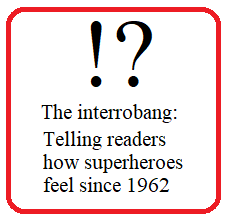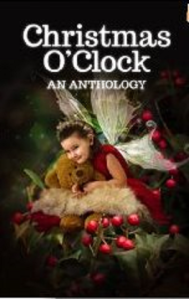 An interesting conversation occurred in one of the many writers’ forums I frequent on Facebook, a discussion of the use of the ‘interrobang’ in modern literature. When the discussion was over, several new-to-the-craft writers lay dead on the floor, and two editors were blue in the face.
An interesting conversation occurred in one of the many writers’ forums I frequent on Facebook, a discussion of the use of the ‘interrobang’ in modern literature. When the discussion was over, several new-to-the-craft writers lay dead on the floor, and two editors were blue in the face.
Okay, the writers weren’t actually dead unless acute embarrassment is a terminal condition. (Give me a break—I’m an author, and I write fiction.) However, I’m pretty sure the editors were blue in the face.
Anyway, most editors agree that the interrobang is not an accepted form of punctuation for anything but comic books, manga, and possibly, text messages. I thought about writing a new post on the subject, but instead, I have decided to be environmentally friendly and recycle this perfectly good post from May of 2017.
Enjoy!
A little power is a dangerous thing, and certain punctuation has power.
Exclamation points!
Em dashes—
Ellipses…
These are all wonderful, fun things to play with, but making too free with the power punctuation makes the narrative too breathless, or in the case of ellipses, too slow.
When prose is well-written, it conveys the excitement of the moment without force. A good author doesn’t resort to creating excitement with the overuse of exclamation points as this makes the narrative feel frantic. It tells the reader what to think, rather than showing them a scene that is exciting.
When I am laying down the first draft, I am just as guilty of filling the manuscript with exclamations, em dashes, and ellipses as anyone. I am in a rush to get the ideas down on paper.
This is a subconscious shorthand for the second draft, which is where I take those telling scenes and show them.
I do a global search for exclamation points, ellipses, and em dashes. At each one, I examine the scene. Nine times out of ten, I reword it to show the action and change the power punctuation to a period. Many times I find the em dash or ellipsis was not needed.
Exclamation points, em dashes, and ellipses are like speech tags. They are necessary, but simplicity is the key to making them unobtrusive. Generally, dialogue worded powerfully, along with the way you visualize and then show the attitude of the characters and their situation will serve to convey the emotions.
When it’s done right, you will only need one or two morsels of power punctuation, and the punctuation you use won’t be a needle in the eye of the reader. The common, garden-variety period or comma will usually serve the situation well and won’t throw the reader out of the book.
All punctuation has its place and should be used appropriately. For the most part, the way you have set the scene combined with the dialogue itself will convey the tension without your having to sprinkle the narrative with power punctuation.
I suggest you do a global search and change most of them to a period.
 But what about !? These mutant morsels of madness are called “interrobangs.”
But what about !? These mutant morsels of madness are called “interrobangs.”
Comic books frequently employ interrobangs, generally because the authors are limited on space for narrative and use creative punctuation as a shorthand. They do this as a way of telling the story.
It’s your narrative, so of course, you will do as you see fit. However, the exclamation point before a question mark is not accepted punctuation in literature of any genre but comic books, so don’t be surprised if you receive negative feedback in reviews. Interrobangs are a writing habit the professional writer will avoid if they want to be taken seriously.
Peppering the narrative with exclamation points and interrobangs is a form of telling the reader “this is exciting” as opposed to showing the excitement. We want to immerse the reader, not blow them out of the manuscript.
Power punctuation used too freely becomes a bludgeon, beating the reader with how exciting it all is.
A great resource for ideas on how to convey strong emotions without telling the reader what the character is feeling is The Emotion Thesaurus: A Writer’s Guide to Character Expression by Angela Ackerman and Becca Puglisi.
All sentences should have only one punctuation mark to signify the end. “Ahah!” you say. “What about the ellipsis?”
When the ellipsis falls at the end of the sentence, it should be three dots followed by the required punctuation.
- If the ellipsis falls at the end of a sentence in dialogue, use a comma at the end of it followed by a speech tag. “But, my dog…,” Annie said, her brow furrowed.
- If no speech tag is used, employ a period, question mark, etc. “But, my dog….” Annie’s brow furrowed.
This is because the ellipsis at the end of a sentence symbolizes unspoken words, trailing off. The ellipsis is not punctuation.
The em dash at the end of a sentence symbolized cut off words, so no punctuation is needed.
This is what the Chicago Manual of Style says:
Use an ellipsis for any omitted word, phrase, line, or paragraph from within a quoted passage. There are two commonly used methods of using ellipsis: one uses three dots for any omission, while the second makes a distinction between omissions within a sentence (using three dots: . . .) and omissions between sentences (using a period and a space followed by three dots: . …). An ellipsis at the end of a sentence with no sentence following should be followed by a period (for a total of four dots).
 Once again, I emphasize that we use the Chicago Manual of Style as our grammar reference guide if we are writing fiction and intend to publish it. The Chicago Manual of Style is written specifically for writers, editors, and publishers and is the publishing industry standard. All the editors at the major publishing houses own and refer to this book when they have questions.
Once again, I emphasize that we use the Chicago Manual of Style as our grammar reference guide if we are writing fiction and intend to publish it. The Chicago Manual of Style is written specifically for writers, editors, and publishers and is the publishing industry standard. All the editors at the major publishing houses own and refer to this book when they have questions.
If you develop a passion for words and ways in which we bend them, as I have done, you could soon find your bookshelf bowing under the weight of your reference books. Writing is not a one-size-fits-all kind of occupation. No style guide will fit every purpose, but the Chicago Manual of Style comes closest.
However, some things are universal:
Exclamation points must be used sparingly.
Ellipses symbolize omitted words and are not punctuation, so when the conversation trails off, you must add ending punctuation. My God, I thought. What…?
Em dashes can either set off phrases—like this—or if used at the end of a sentence an em dash can indicate cut off words. Consider the following quote from A Dog’s Tale by Mark Twain. In this case, you do not add punctuation:
It did seem to me that life was just too lovely to—
It is your task to write the narrative so that it shows the character’s emotions. Their eyes will widen, or their mouth will drop open, or they will stop and stare. When it comes to punctuation, do you tell, or do you show?
You make the decision, but I see the interrobang and the overuse of the exclamation point as if they were too much seasoning. They are strong flavors that can ruin the taste of the narrative.
Sources and Attributions:
Power Punctuation by Connie J. Jasperson was first published here on Life in the Realm of Fantasy on May 17, 2017.
The Chicago Manual of Style (16th ed.), page 639 sections 13.51 – 13.55 The Chicago Manual of Style 16th edition text © 2010 by The University of Chicago.
The Chicago Manual of Style (16th ed.), page 334 Section 6.84 Em dashes to Indicate Sudden Breaks, The Chicago Manual of Style 16th edition text © 2010 by The University of Chicago.
A Dog’s Tale, by Mark Twain. © 1904 Harper & Brothers, via Wikipedia, The Free Encyclopedia, https://en.wikipedia.org/w/index.php?title=A_Dog%27s_Tale&oldid=769178379 (accessed May 16, 2017).



























